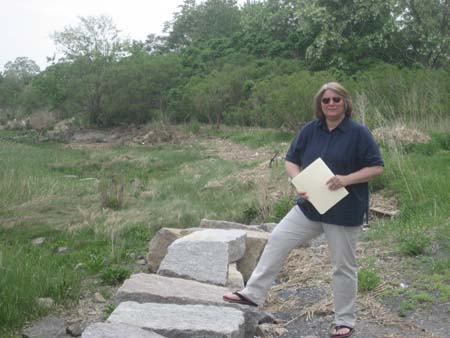September 29, 2011

Residents of the Port Norfolk neighborhood are showing signs of guarded optimism following a renewed effort by state agencies to turn the former Shaffer Paper Company site into a riverside park.
Plans to restart the stalled project were unveiled during a Port Norfolk Civic Association meeting last week at the Port Norfolk Yacht Club not far from the 15-acre area. While the Department of Conservation and Recreation announced they have hired a design team and have begun surveying the area for hazardous waste, repeated failures to secure funding for the project have kept the site in limbo for the past 30 years.
“It looks like there’s a light at the end of our journey,” said PNCA president Mary McCarthy prior to the announcement.
Despite McCarthy’s optimism, many in attendance, including state Rep. Marty Walsh, said they would believe the work when they see it. “We’ve met with about 10 different [DCR] commissioners on this one,” Walsh said. “Hopefully we won’t have to meet another before the project is done.”
The Shaffer site was last considered for remediation and development in 2008, but the $7 million proposal, which was signed off on by the Senate, was ultimately shot down due to funding limitations. DCR representatives said they will be looking for federal Department of Transportation funding, rather than state dollars to bankroll development.
A DCR representative present at the meeting said planners hope to return to the community for planning input around the end of October or beginning of November in hopes of finalizing a design between next spring and summer.
If a design can be established by that time, DCR will then begin the permitting process and hope to have the project out to bid no later than December 2012 with construction to occur some time between 2013 and 2014. A DCR spokesperson said the project will have a budget of approximately $4 million for remediation and construction.
Prior to developing the site, DCR representatives said there would have to be an extensive cleanup program to remove any hazardous waste that has accumulated on the site while it served as a toxic waste dump, lumber yard, paper mill, and metal fabricating plant. The process would include adding a three-foot deep layer of clean topsoil which designers say could be used to add contours and elevation to the largely flat site.
A 2008 survey by Woburn-based GEI Consultants found elevated levels of heavy metals including lead and polycyclic aromatic hydrocarbons in the area, as well as some trace signs of polychlorinated biphenyls that do not pose a major risk according to Environmental Protection Agency guidelines.
The initial design for the park, which includes a mix of “active” play areas and “passive” fields and walking paths was met with questions by residents, who called for a design that accentuates the natural areas that have developed over the past decades.
While the preliminary design would preserve approximately 6 acres of tidal mud flats running along the Neponset River, residents like neighborhood conservationist Mary Lyons are calling for as much of the site to be preserved as possible.
“A lot of the natural habitat has grown back in 30 years,” Lyons said. “If there are parts of the area that are not contaminated, we want to see those areas left alone so people can enjoy the area untouched.”
Residents also voiced concerns that residents from outside neighborhoods would influence the public commentary on park design. But Rep. Walsh said that the park’s isolated location would mean fewer people beyond nearby residents and cyclists passing through the completed site through the Neponset Trail and so residents would likely be the only group to form organized opinions on the matter.
“Because it’s a state park, people from other communities will be able to comment on the design,” Walsh said. “But this park is important to the neighborhood, they are going to be the ones speaking out most strongly during the process.”
While construction of the park is far from guaranteed, Lyons and other neighbors living near the site said they hope the hazardous waste removal is completed as soon as possible. “Having a new park here is a great opportunity,” Lyons said. “But the fact is we’ve been living next to toxic waste for years now. We need to make this area safe for the community.”


